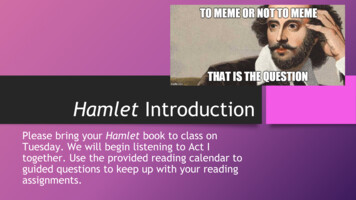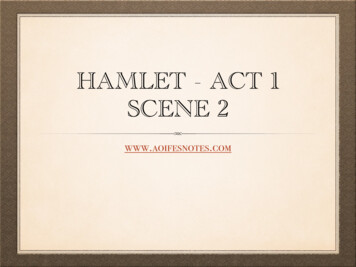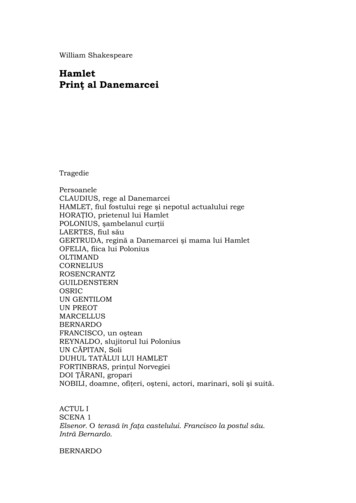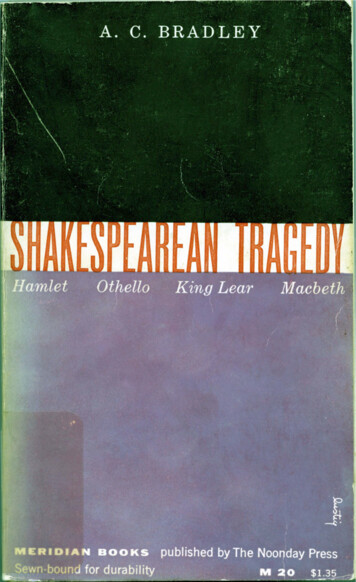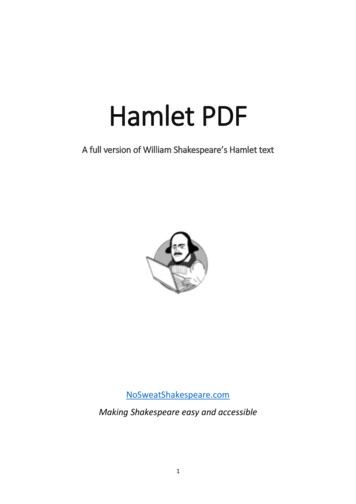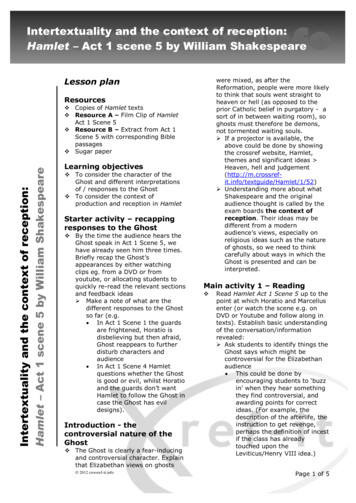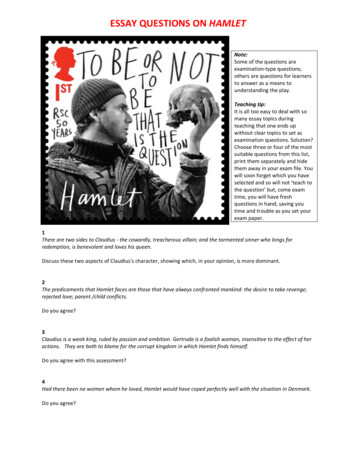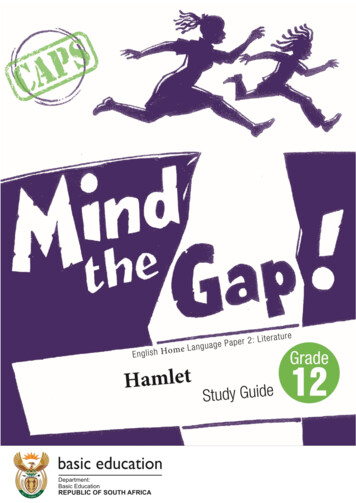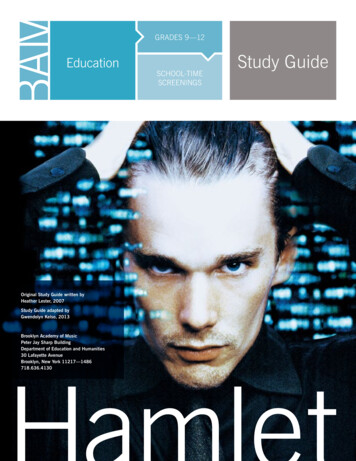
Transcription
grades 9—12EducationOriginal Study Guide written byHeather Lester, 2007Study Guide adapted byGwendolyn Kelso, 2013Brooklyn Academy of MusicPeter Jay Sharp BuildingDepartment of Education and Humanities30 Lafayette AvenueBrooklyn, New York 11217—1486718.636.4130SCHOOL-TIMESCREENINGSStudy Guide
Dear Educator,Welcome to BAM’s Shakespeare on Film and to the study guidefor Michael Almereyda’s Hamlet from the play by William Shakespeare. The film sets the play in 2000 in a sleek, corporate Manhattan rife with cell phones and laptops, and casts Hamlet, playedby Ethan Hawke, as a brooding film student. Whether or not yourstudents have studied the play, Almereyda’s bold cinematic approach will immerse them in Shakespeare’s story of corruption andrevenge.Prior to attending the screening at BAM, you and your studentswill receive an in-school pre-screening workshop with a BAMteaching artist. Immediately following the screening, there will be a30- to 45-minute discussion with the filmmakers. Please arrangefor your class to remain for the talk and prepare your students forthis question and answer session. It is a rare occasion to engage inan open discussion with other New York City students and teachers, as well as professional filmmakers.SYNOPSIS OF THE FILMPrince Hamlet returns from college following the mysteriousdeath of his father King Hamlet, the CEO of Denmark Corporation.Hamlet is troubled and suspicious. His mother Gertrude has hastilyremarried his father’s younger brother, Claudius. Claudius has, inturn, taken over as King and CEO of Denmark Corporation. Meanwhile, Hamlet and Ophelia (his girlfriend) try to work outtheir relationship, but Ophelia’s father Polonius and brotherLaertes keep them apart. Hamlet’s father appears to his son asa ghost and reveals that his brother Claudius murdered him. TheGhost demands that Hamlet seek revenge. Hamlet grows more andmore agitated as he devises a complicated plan to prove his uncle’sguilt.2 · HAMLET STUDY GUIDEThis Guide aims to help you prepare your students for viewing the film. Each section offers a unique lens into the film, andprovides background information and activities to use in yourclassroom. Many of the activities require no previous knowledge ofShakespeare’s Hamlet, while others will deepen a classroom studyof the play. Please use the activities that most align with yourcurricular goals, and consider adapting one or more when studying other films or Shakespeare plays. Our goal is to develop yourstudents’ film literacy so that they will become educated, critical,and inspired viewers of Hamlet and other films.All the activities align with and incorporate the methodology ofCommon Core State Standards, encouraging critical thinking thatgoes deep into the directorial intent and nuance of the film. Additionally, this guide aligns with the NYC Department of Education’sBlueprints for the Arts tesGhostEthan HawkeDiane VenoraKyle McLaughlinBill MurrayJulia StilesLiev SchreiberSam or of PhotographyProduction DesignerEditorMichael AlmereydaMichael AlmereydaCarter BurwellJohn de BormanGideon PonteKristina Boden
Great Literature on Film:William Shakespeare’s HamletFilmmakers have been adapting Shakespeare’s plays for the bigscreen ever since cinema began in the late 1800s. The timelessstories make for great movies. Some fans argue that film is theideal way to experience Shakespeare because the sound andcinematography give audiences the best access to the plays’language and emotional intensity.The Internet Movie Database lists ninety-four versions of Hamlet,making it the most frequently produced Shakespeare play on film.In addition to Michael Almereyda’s Hamlet, other well-knownversions ence OlivierBill ColleranFranco ZefferelliKenneth BranaghCampbell ScottLaurence OlivierRichard BurtonMel GibsonKenneth BranaghCampbell ScottA film director is the creative force behind a movie. He /she isresponsible for how the filmmaking elements (cinematography,set, costumes, sound, acting, editing) work together to achievea specific vision for the film.A director’s vision is the overall concept of a film (look, feel,meaning, and impact).Shakespeare’s dramatic texts invite endless interpretation, and filmversions of Hamlet vary greatly depending on the director’s visionfor the play on screen. In filming Shakespeare in particular, an essential part of the director’s vision is how he or she chooses to editthe language and interpret the original text.Directors edit Hamlet both for artistic purposes, and because thefull text runs more than four hours. Kenneth Branagh’s 1996 version is notable in that it includes all of Shakespeare’s language.Michael Almereyda’s Hamlet is a fast 113 minutes. He cuts halfthe text, reorders some scenes, and intersperses lines from different parts of the play. Shakespeare purists may question why thefilm omits key scenes such as the opening (1.1), Ophelia’s reportof Hamlet’s visit to her (2.1), and the dialogue of the “play withina play (3.2).” Almereyda has exchanged the edited text with carefully crafted cinematic choices. He also includes wordless scenesthat do not occur in Shakespeare’s original to extend the plot andmeaning.3 · HAMLET STUDY GUIDE
CLASSROOM ACTIVITYThe Director’s Vision & Elements of FilmmakingThis activity has been adapted from a lesson designed by MichaelLoMonico with his permission.OverviewStudents view several film versions of the same sceneand analyze the effect of filmmaking elements and theinfluence of the director’s vision. *If your students arestudying the play, this is an opportunity to comparethe original text of the play to the adaptations. However,students need not know the play to do this activity.ObjectiveExpert Group Viewing Tasks:Screenwriting (optional*): compare the text of the play tothe film. Note missing or added lines.Cinematography: Note/describe camera movement,angles, lighting, and the effect of editing.Costume and Set Design: Note/describe sets, costumes,and props. Notice style, color, details, and symbols.Sound Editing: Listen for and describe all music, background sounds, and sound effects.Acting: Note/describe the varying performances. Noteaccents, subtext, and emphasis of words.Students will understand the elements of filmmaking andgrasp how directorial choices influence a film.Closing questions: How did each director’s vision differ?Which version did you find most effective and why?SuppliesBlueprint: Arts Making and Literacy in the ArtsSeveral films of Hamlet cued to the same scene.Suggested clips (click names below):1.2 Kenneth BranaughDavid TennantLawrence Olivier3.4 the closet scene—Lawrence OlivierDavid Tennant or5.1 Ophelia’s funeral: Kenneth BranaughDavid TennantCCSS.ELA-Literacy.SL.9-10.1d Respond thoughtfully to diverse perspectives, summarize points of agreement and disagreement, and, whenwarranted, qualify or justify their own views and understanding and makenew connections in light of the evidence and reasoning presented.Copies of the original text of the scene. Download free n the role of the director and the director’s visiondefined above. Divide the class into five Expert Groupsoutlined below and assign each group the relatedviewing task. Ask students to take notes as they vieweach scene. After each viewing, discuss the sceneoverall and ask for input from each group. Rotateexpert groups for each version.4 · HAMLET STUDY GUIDECCSS.ELA-Literacy.SL.11-12.1d Respond thoughtfully to diverse perspectives; synthesize comments, claims, and evidence made on all sidesof an issue; resolve contradictions when possible; and determine whatadditional information or research is required to deepen the investigationor complete the task.CCSS.ELA-Literacy.SL.9-10.2 Integrate multiple sources of informationpresented in diverse media or formats (e.g., visually, quantitatively, orally)evaluating the credibility and accuracy of each source.CCSS.ELA-Literacy.SL.11-12.2 Integrate multiple sources of information presented in diverse formats and media (e.g., visually, quantitatively,orally) in order to make informed decisions and solve problems, evaluating the credibility and accuracy of each source and noting any discrepancies among the data.
Understanding Shakespeare’s Language through PerformanceShakespeare wrote his plays for actors to perform and for audiences to see and hear. When students act Shakespeare’s words before seeingstage or film versions of his plays, they make important personal connections to the dramatic text and discover they can understand and enjoythe complex language.CLASSROOM ACTIVITYSynopsis CircleNote: the synopsis below aims to outline the film’s story without revealing the moreunexpected plot points.OverviewThis activity gets students up on their feet reading, analyzing, andspeaking Shakespeare’s text. Students may recognize their quote inthe film. The activity can be a springboard into discussing Shakespeare’s language.Blueprint: TheatermakingCCSS.ELA-Literacy.RL.9-10.3 Analyze how complex characters (e.g., those withmultiple or conflicting motivations) develop over the course of a text, interact with othercharacters, and advance the plot or develop the theme.CCSS.ELA-Literacy.RL.11-12.3 Analyze the impact of the author’s choices regardinghow to develop and relate elements of a story or drama (e.g., where a story is set, howthe action is ordered, how the characters are introduced and developed).ObjectiveStudents will speak Shakespeare’s language and become familiarwith the plot of the film. The order of the lines in the film differsslightly from the play.SuppliesPhotocopied quotes cut apart.InstructionsGive each student a numbered quote. Double up or omit quotes toaccommodate numbers of students.1.Students consult with one another to decide what their linemeans. The exact meaning is not important.2.Students with copies of the play may find their quote in theplay.3.Students move around the room and practice their lines aloudat the same time.4.Students add a simple gesture to go with the line.5.After ten minutes of rehearsal, students gather in a circle inquote number order to present Hamlet. Teacher reads thenarration aloud (be dramatic!), stopping to call out each quotenumber. As each student hears his/her number, he/she stepsforward and reads out his/her quote with added gesture (loud,clear, and bold)6.At the screening, listen and watch for your quote.Synopsis of Michael Almereyda’s Hamlet from the playby William ShakespeareNew York City 2000, Hotel Elsinore. The King and CEO ofDenmark Corporation is dead. The king’s son Hamlet returnsfrom school suspecting foul play.5 · HAMLET STUDY GUIDE(1).Hamlet’s uncle Claudius has taken over the company andmarried Hamlet’s widowed mother Gertrude(2). Although shocked and angry, Hamlet promises his mother hewill try to cheer up(3). The more he thinks about it, the more upset Hamlet is abouthis father’s death and his mother’s marriage(4). Hamlet’s friend Horatio tells him he has seen his father’sghost(5). Horatio tries unsuccessfully to speak to the terrifying ghost(6). Hamlet decides to find out what the ghost wants and knowsit’s probably bad news(7). Meanwhile, Hamlet’s girlfriend Ophelia gets a lecture fromher older brother Laertes not to trust Hamlet(8). Polonius gives his son Laertes unsolicited advice.(9). Hamlet encounters the Ghost(10). The Ghost tells Hamlet he must avenge his murderby Claudius(11). The Ghost sums up the awful situation(12). Hamlet realizes that life can be very strange(13). He feels overwhelmed by the responsibility of avenging hisfather’s death(14). Polonius forbids his daughter Ophelia to see Hamlet(15). Later, Polonius catches Hamlet and Ophelia together andconfiscates a letter Hamlet wrote to her(16). Furious, Polonius reports Hamlet’s behavior to Claudiusand Gertrude(17). Hamlet becomes more agitated and contemplates lifeand death(18). Claudius hires Hamlet’s friends to spy on him but hisconversation confuses them(19). Hamlet hatches an elaborate plan to make a film thatwill prove Claudius is a murderer(20). Polonius forces Ophelia to break up with Hamlet(21). Ophelia’s meeting with Hamlet does not end well(22). Hamlet screens his film “The Mousetrap,” the story of amurdered King. Claudius reacts in horror when he realizesthat Hamlet knows he did it(23). Hamlet accuses his mother of adultery(24). Then, Hamlet makes a terrible mistake(25). He manages to escape Claudius’ plan to have him killed,but things get much worse(26). Claudius sets up a duel between Laertes and Hamlet(27). Hamlet finally takes revenge on Claudius but not withouttremendous loss(28). At last, Hamlet’s story ends(29). Was this Hamlet’s destiny
SYNOPSIS CIRCLE QUOTES1.I have of late—but wherefore I know not--lost all mymirth. —Hamlet, 2.2.303-30416. O dear Ophelia I love thee best, most best, believe it.—Hamlet, 2.2.1202.Therefore our sometime sister, now our Queen, have wetaken to wife. —Claudius, 1.2.8-1417. Your noble son is mad. —Polonius, 2.2.923.I shall in all my best obey you, madam.—Hamlet, 1.2.12019. There is nothing either good or bad but thinking makesit so. —Hamlet, 2.2.253-2544.It is not, nor it cannot come to good. —Hamlet, 1.2.1585.My lord, I think I saw him yesternight.—Horatio, 1.2.18920. The play’s the thing wherein I’ll catch the conscience ofthe king. —Hamlet, 2.2.6176. Stay illusion. If thou hast any sound or use of voice,speak to me. —Horatio, 1.1.127-12918. To be or not to be that is the question. —Hamlet, 3.1.5621. My lord, I have remembrances of yours that I havelonged long to redeliver. —Ophelia, 3.2.92-9322. Get thee to a nunnery. —Hamlet, 3.1.1217.Would the night were come, til then still my soul. Fouldeeds will rise. —Hamlet 1.3.256-25723. Give me some light. Away! Lights, lights, lights!—Claudius, 3.2.2758.Perhaps he loves you now but you must fear his willis not his own. —Laertes, 1.3.114-11724. You shall not budge. You go not till I set you up a glassto see the inmost part of you. —Hamlet, 3.4.19-219.This, above all, to thine own self be true.—Polonius, 1.3.7825. What a rash and bloody deed is this?—Gertrude, 3.4.2810. I am thy father’s spirit, doomed for a certain term towalk the night. —Ghost 1.5.9-1026. O heavens, is possible a young maid’s wits should be asmortal as an old man’s life? —Laertes,4.5.159-16011. Revenge his foul and most unnatural murder.—Ghost 1.5.2527. A hit, a very palpable hit. —Osric, 5.2.28112. O, horrible! O, horrible! Most horrible! —Ghost 1.5.2513. There are more things in heaven and earth, Horatio,than are dreamt of in our philosophy.—Hamlet, 1.5.16614. The time is out of joint. O cursed spite, that ever I wasborn to set it right. —Hamlet, 1.5.18815. Lord Hamlet is a prince, out of thy star. This must notbe. —Polonius, 2.2.141-1426 · HAMLET STUDY GUIDE28. I am dead. —Hamlet, 5.2.339-34029. Good night, sweet prince. And flights of angels sing theeto thy rest. —Horatio, 5.2.359-36030. Our wills and fates do so contrary run that are devicesstill are overthrown; our thoughts are ours. Our endsnone of our own. —Player King, 3.2.217-219
The WORLD OF lm critics used these words to describe Michael Almereyda’sHamlet. As the director, he achieved the mood, style and look—or “the world of the film”—by choosing specific elements of setting,cinematography, lighting, sound, and costumes. His choices affecthow the audience experiences the story, characters, and themes.Through analyzing the world of the film, students begin to interpretthe film’s meaning and start to understand how a director’s choicesaffect the audience.Guiding Questions:· Answer these questions as you view Hamlet (or any other film) toidentify the world of the film:· Describe the film’s setting (time and place). What mood does itevoke and how?· Consider the lighting (outdoor or indoor, natural or electric). Howdoes it create atmosphere and what is the effect?· Listen closely for sounds in the film. What do these noises meanin the film?· Take note of music throughout the film. What feeling does themusic inspire?· Notice the characters’ costumes. What aspect of each characterdoes each costume emphasize?· Pay attention to camera shots. What do the angles and speed ofediting tell you about the story?· Create a list of vivid words to characterize the world of the film.Be Sure to NoticeAs you view Hamlet, closely consider these three aspects of the film.NEW YORK CITYThe film is set in Manhattan. How does Almereyda portray the cityand what is the effect? Some scenes take place inside and someoutside. How does location impact a scene’s feeling? In what waysis the Guggenheim Museum effective for the scene that takes placethere?TECHNOLOGYNearly every moment of the film includes some electronic gadget:cell phones, computers, video cameras. How do the characters useeach kind of technology? What does each kind of technology represent to you? What does it tell you about the characters? Almereydamade the film in 2000. If he had made the film in 2013, whatnewer forms of technology might he feature in the film?MEDIAAlmereyda weaves television and movies into the background ofseveral scenes. Notice the films playing on the monitors in the videostore and the television shows playing in Hamlet’s room. What effectdo they have? What do the crowds and paparazzi in thefilm represent?7 · HAMLET STUDY GUIDECLASSROOM ACTIVITYComparing the Original Play and the FilmPrevious knowledge of the play is not necessary for this activity but you willneed copies of Act 1, scene 1.OverviewAlmereyda entirely cut Act 1, Scene 1 from his film versionof Shakespeare’s Hamlet. On stage, this scene is crucial tointroduce the play’s mood, setting and plot points. By reading this short scene aloud before the screening, students willunderstand the dramatic purpose of this scene.Blueprint: Literacy in the Arts and Making ConnectionsCCSS.ELA-Literacy.RL.9-10.5 Analyze how an author’s choices concerning howto structure a text, order events within it (e.g., parallel plots), and manipulate time (e.g., pacing, flashbacks) create such effects as mystery, tension, orsurprise.CCSS.ELA-Literacy.RL.11-12.3 Analyze the impact of the author’s choicesregarding how to develop and relate elements of a story or drama (e.g., wherea story is set, how the action is ordered, how the characters are introduced anddeveloped).CCSS.ELA-Literacy.SL.9-10.4 Present information, findings, and supportingevidence clearly, concisely, and logically such that listeners can follow the line ofreasoning and the organization, development, substance, and style are appropriate to purpose, audience, and task.CCSS.ELA-Literacy.SL.11-12.4 Present information, findings, and supportingevidence, conveying a clear and distinct perspective, such that listeners canfollow the line of reasoning, alternative or opposing perspectives are addressed,and the organization, development, substance, and style are appropriate topurpose, audience, and a range of formal and informal tasks.ObjectiveStudents will analyze how Shakespeare created the world ofthe play in Act 1, scene 1. They will consider why Almereydaomitted the scene and what he does cinematically to createthe world of the film. Students will then engage in a thoughtfuldiscussion and exchange of ideas.SuppliesA copy of Act 1, scene 1 for each student. Free online at www.opensourceshakespeare.orgInstructionsAs a class, read the scene aloud three times to become familiarwith the sound, images, and meanings of the language in thescene. Give as many students as possible a chance to read.Stop between readings to discuss what is going on in the sceneand the ways that the scene creates mood and setting.Why is this scene important for a stage version of the play?What words does Shakespeare use? How does Shakespeare’sword choice help set the mood? When you see the movie,consider why Almereyda cut this scene and what he does torecreate the mood and setting of the missing scene. If youwere to direct this scene, what would it look like? Whowould you cast? Why?
themes on film: thinking visuallyTo interpret a story as images on film, a director must think visually. He or she uses the visual language of film to represent astory’s themes and meaning. Often directors utilize visual motif andsymbolism as a way to emphasize a particular theme within thestory or to connect the theme to a larger concept. For example, inHamlet, technology gadgets represent the characters’ inability todeal with reality. Almereyda’s depiction also suggests that technology in our culture is a tool of deception.Metaphor in film can reinforce a story’s meaning by eliciting anemotional or visceral response from the audience. For example,when Ophelia imagines plunging into the swimming pool, the powerful cinematic moment simulates her feeling of isolation and needfor escape. The moment foreshadows her drowning.Directors also use visual images to raise questions and provokethought. The chart below includes the play’s major themes,examples of how Almereyda depicts these themes, and relatedquestions that the film raises.THEMEPowerEXAMPLES IN THE FILMQUESTIONSManhattan’s corporateAmerica: Denmark CorporationWhat kind of power isthis? Is it good or bad?·· luxury apartments, expensiveclothes, paparazziCorruption· Music is foreboding. Themood is eerie.· Hamlet’s close friends arewary of everything.LOVE· Hamlet and Ophelia stealunspoken moments together.· Ophelia waits for Hamlet. Hewatches video of her.BetrayalRevenge··Ophelia wears a wire tap.Rosencrantz and Gildensternplot by phone with Claudius.· The ghost physically touchesHamlet.· Hamlet’s uses his film toagitate Claudius.What else signalscorruption? What dothese signals predict?Do they truly love eachother? What happensto love in this world?Who can trustwhom? How istechnology involved incharacters’ mistrust ofone another?Is revenge requiredfor Hamlet? Why is hesuccessful only after hehimself is done in?· Guns become the weapon ofrevenge.Madness· Claudius ambushes Hamletin the cramped Laundromat.· Ophelia has a screamingepisode at the Guggenheim.Inaction· Hamlet is obsessed withviewing video of his father.· The video store has rows of“action” films.8 · HAMLET STUDY GUIDEWho is truly mad?What does it mean—inthe world of the film orin your own life—to be“mad?”How does the filmemphasize Hamlet’sprocrastination?CLASSROOM ACTIVITYComparing the Original Play and the FilmOverviewWhen students look closely at how directors depict themes onscreen, they begin to understand how films can reflect a text’smeaning.Blueprint: Literacy in the Arts and Making ConnectionsCCSS.ELA-Literacy.RL.9-10.2 Determine a theme or central idea of a text and analyzein detail its development over the course of the text, including how it emergesand is shaped and refined by specific details; provide an objective summary ofthe text.CCSS.ELA-Literacy.RL.11-12.2 Determine two or more themes or central ideas of atext and analyze their development over the course of the text, including howthey interact and build on one another to produce a complex account; providean objective summary of the textObjectiveStudents will analyze themes in the film. If they choose, theywill reflect these themes in visual art.InstructionsChoice #1: Listed below are additional themes featuredin the play and/or film. Choose several and explain howAlmereyda depicts each in the film. How does the filmextend or expand on these ideas? Note symbolism, extrascenes, and strong visual images.Choice #2:Select two or more themes from the list belowand watch for them in the film. Afterwards, capture thethemes in a visual art form of your choice (drawing,painting, collage). Use symbolism, color, and image tocapture your interpretation of the theme’s meaning in the film.SPYINGDISEASEGARDENS and NATUREDEATH and SUICIDERELIGIONART vs. CORPORATISMCHILDREN and PARENTSINSIDE and OUTSIDEALONE and WITH OTHERSDISEASE and POISONFORTUNE and FATEFRAILTY
interpreting key scenesAdaptations of Hamlet often differ most in how the director interprets key scenes. Many of these scenes present challenges thedirector must address for the scene to be effective. Shakespeareprovides dramatic devices and language to tackle the challengeonstage. In film adaptations, directors often turn to cinematic tools.Below are some key scenes, the challenges each presents, dramaticapproaches suggested by the play, and Almereyda’s choices in thefilm.The Ghost (Act 1, Scene 4 and Act 1, Scene 5)Challenge: The ghost entreats Hamlet to avenge his father’s murder.He must be believable as a formidable spirit.The Play: The other characters describe and react to the ghost asfrightening.The Film: Special effects make the ghost otherworldly. He is translucent and evaporates. He grabs Hamlet fiercely.Notice: The ghost appears later in the film but does not speak. Whyis he there?The Mousetrap (Act 3, Scene 3)Challenge: Hamlet presents a play (“The Mousetrap”) that Claudiusrecognizes as his murder of Hamlet’s father.The Play: A troupe of actors performs Hamlet’s show. Hamletcoaches the performers on acting.The Film: The “play within a play” becomes a film within a film thatHamlet screens for a shocked Claudius.Notice: Hamlet’s film tells the story of his father’s murder throughimage rather than narrative.Final Swordfight (Act 5, Scene 2)Challenge: The play culminates in a dramatic swordfight with multiple deaths by injury and poisoning.The Play: The language of the scene is fast and describes in detailthe complicated proceedings.The Film: The swordfight is a fencing duel. A gun is used. The storyis told through action and minimal lines.Notice: Each character has powerful emotional reactions during thescene that they express silently.9 · HAMLET STUDY GUIDECLASSROOM ACTIVITYFilming Ophelia’s DrowningOverviewIn the play, Ophelia’s drowning occurs offstage and Gertrudereports it in a speech filled with imagery. Almereyda cut thisspeech and replaced it with a powerful visual image that recreates the tone of the text.Blueprint: Film Literacy and Making ConnectionsCCSS.ELA-Literacy.RL.9-10.7 Analyze the representation of a subject or a key scene intwo different artistic mediums, including what is emphasized or absent in eachtreatment (e.g., Auden’s “Musée des Beaux Arts” and Breughel’s Landscape withthe Fall of Icarus).CCSS.ELA-Literacy.RL.11-12.7 Analyze multiple interpretations of a story, drama, orpoem (e.g., recorded or live production of a play or recorded novel or poetry),evaluating how each version interprets the source text. (Include at least one playby Shakespeare and one play by an American dramatist.)ObjectiveStudents will explore how Shakespeare’s dramatic languageand imagery can inform cinematic decisions.InstructionsRead the lines below silently and then aloud. As you do so,visualize the images the speech describes. Discuss the moodthe images evoke. Describe how you would depict this sceneon film. You may choose to create a storyboard to accompanythe text. If you edit the text, explain how you would visually recreate the tone of the text.Gertrude: Your sister’s drown’d, Laertes.Laertes: Drown’d! O, where?Gertrude: There is a willow grows aslant a brook,That shows his hoar leaves in the glassy stream.There with fantastic garlands did she comeOf crowflowers, nettles, daisies, and long purples,That liberal shepherds give a grosser name,But our cold maids do dead men’s fingers call them.There on the pendant boughs her coronet weedsClamb’ring to hang, an envious sliver broke,When down her weedy trophies and herselfFell in the weeping brook. Her clothes spread wideAnd, mermaid-like, awhile they bore her up;Which time she chaunted snatches of old tunes,As one incapable of her own distress,Or like a creature native and induedUnto that element; but long it could not beTill that her garments, heavy with their drink,Pull’d the poor wretch from her melodious layTo muddy death. (4.7.164-183)
creating characters: casting & actingHAMLETActors consider the role of Hamlet to be among the most coveted ofparts. Many directors choose to cast only very experienced actorsas Hamlet because of the performance skills the role demands. Thecharacter allows for a range of interpretations. The type of actor castas Hamlet has varied in age, appearance, race, and even gender.Notice in the film: Hamlet’s clothes set him apart from the worldof Denmark Corporation. Almereyda makes Hamlet a film studentto emphasize certain aspects of his personality. Note what Hamletwatches on television and video.Questions: Based on the film, how would you describe Hamlet’spersonality? What makes Ethan Hawke a good Hamlet?PoloniusFather to Laertes and Ophelia and counselor to the King, Polonius isoften played as a fool although he speaks many famous lines suchas “neither a borrower or a lender be;” “brevity is the soul of wit;”and “to thine own self be true.”Notice in the film: Watch how Polonius shows his feelings for othercharacters. He ties Ophelia’s shoe as if she is a child and brings herbirthday balloons. He helps Laertes pack his suitcase and secretlyputs money in his jacket pocket.Questions: Do you think Polonius is a good parent? Does Bill Murrayplay Polonius as a wise man or as a fool?OpheliaGertrudeHamlet’s mother causes her son great anxiety. He is stunned thatshe has married his uncle thereby committing adultery. While shedid not know that Claudius murdered her husband, Hamlet holdsher responsible for his deceit.Notice in the film: Gertrude seems the perfect corporate wife toClaudius. Hamlet’s videos show her as a loving wife to his father.Watch Gertrude when Hamlet confronts her. Pay attention to herreactions during the fencing match.Questions: Does Gertrude redeem herself? How would you characterize Diane
THIs guIdE aims to help you prepare your students for view-ing the film. Each section offers a unique lens into the film, and provides background information and activities to use in your classroom. Many of the activities require no previous knowledge of shakespeare's Hamlet, while others will deepen a classroom study of the play.
